Fog, a common yet enigmatic phenomenon, often shrouds landscapes in mystery, transforming scenes into something almost surreal. Yet, there exists another fascinating aspect of fog—the mysterious disappearances that have left researchers and enthusiasts perplexed for centuries. In the serene tranquility of national parks, where nature’s beauty knows no bounds, the sudden vanishing of fog has become a subject of both scientific inquiry and popular intrigue. This peculiar occurrence, observed in diverse locations across the globe, challenges our understanding of atmospheric behavior and invites us to explore its underlying causes. From the dense woodlands of Alaska to the misty trails of Michigan, the fog’s transient nature raises questions about climate, geography, and even the interplay of cultural beliefs. As we embark on this journey to decode the mysteries behind these disappearances, we uncover not just the science but also the stories and theories that surround one of nature’s most intriguing phenomena.
Key Takeaways
– Tree Transpiration: Trees release moisture through transpiration, reducing fog in national parks.
– Dense Canopy Airflow: Forest canopies promote airflow, aiding fog dispersion.
– Sunlight Effect: Sunlight heats surfaces, accelerating evaporation and fog dissipation.
– Vegetation Influence: Vegetation type affects airflow, shaping fog behavior.
– Temperature Fluctuations: Fog forms at night and dissipates with rising temperatures.
– Topographical Impact: Terrain influences fog movement, with valleys trapping it and higher elevations allowing dispersion.
– Humidity Levels: Fog duration depends on humidity, with dry conditions reducing formation and excess moisture prolonging it.
– Atmospheric Layers: Fog can be trapped by inversions but disperses when conditions shift.

Understanding the Disappearance of Fog in National Parks
Fog, a common yet enigmatic phenomenon, often shrouds national parks in an eerie embrace. Its sudden disappearance remains a fascinating mystery, driven by a combination of environmental factors. Here’s a breakdown of the key causes:
- Temperature Fluctuations : Fog typically forms when cool air interacts with warmer surfaces, leading to condensation. Its disappearance is often triggered by sunlight, which heats the droplets, causing them to evaporate swiftly. As the sun rises, temperatures rise, accelerating the process.
- Topographical Influences : The varying terrain of national parks plays a crucial role. Fog can become trapped in low-lying areas or along coastal regions but may disperse rapidly over higher elevations or through valleys due to wind patterns and elevation changes.
- Biological Interactions : While fog provides cover for certain animals, particularly birds, its distribution isn’t significantly influenced by biological activity. Environmental factors remain the dominant contributors to fog behavior.
- Diurnal Cycles : Fog generally forms overnight and dissipates with the arrival of sunrise. Clear skies post-fog formation contribute to its rapid disappearance as warmth from the sun melts the droplets.
- Humidity Levels : Dry conditions can inhibit fog formation, while excessive moisture may prolong its duration. The balance of humidity levels directly impacts how long the fog persists before it begins to evaporate.
- Atmospheric Layers : Temperature inversions can trap fog, preventing it from clearing. However, once the inversion layer shifts, the fog can disperse quickly. This dynamic interaction between atmospheric layers explains why fog sometimes lingers or moves abruptly.
Understanding these factors reveals that the disappearance of fog in national parks is a natural process governed by climate, geography, and physics. While the term “mysterious” might suggest supernatural causes, scientific evidence points to a blend of environmental and physical processes at work.
Understanding the Disappearance of Fog
Fog, a common yet enigmatic phenomenon, often puzzles scientists and enthusiasts. While it typically forms due to cool air near the ground meeting warmer air higher up, leading to condensation, its sudden disappearance remains intriguing. Several factors contribute to the dissipation of fog:
- Temperature Fluctuations : Fog tends to dissipate rapidly when the sun emerges, as the warmth of the sun’s rays melts the mist. However, this effect isn’t universal, as fog can persist even on cloudy days, suggesting other influences at play.
- Wind Influence : Wind plays a crucial role in dispersing fog. Strong winds can lift fog particles higher into the atmosphere, preventing them from settling back down. The direction and speed of the wind significantly impact fog duration.
- Geographical Location : Sea fogs, prevalent over oceans, behave differently due to interactions between land and water. Ocean currents and temperature gradients influence fog formation and dissipation, contributing to regional variations. Coastal areas experience distinct patterns compared to inland regions, where mountainous terrains can trap fog longer.
- Pollution Effects : In urban areas with high levels of industry and traffic, fog can linger longer or form smog. Air quality appears to affect fog behavior, potentially trapping it longer or altering its composition.
- Biological Contributions : Certain plants and animals might release substances that influence fog dynamics, though the extent of their impact requires further study.
- Meteorological Predictions : Meteorologists examine variables like temperature thresholds and wind patterns to predict fog dissipation, offering insights into the behavior of fog worldwide.
In summary, the mysterious disappearance of fog is influenced by a complex interplay of environmental factors, including temperature shifts, wind conditions, geographical settings, pollution levels, and biological interactions. Understanding these elements provides deeper insights into the behavior of fog worldwide.

Understanding the Disappearance of Fog in National Parks
Fog in national parks and wooded areas can disappear due to a combination of natural factors:
- Solar Radiation: As the sun rises, it heats the air, causing evaporation and melting the fog. This process is known as radiational cooling.
- Wind Patterns: Strong winds can disperse the fog by carrying it higher into the atmosphere, mixing it with drier air.
- Geographical Factors: Terrain and vegetation play roles. Fog may dissipate faster on higher elevations or hilly areas due to differing wind movements, while dense forests can influence fog behavior through transpiration.
- Temperature Shifts: Rapid changes in temperature, such as those caused by cold fronts or warm fronts, can lead to fog dissipation as clearer skies develop.
- Human Activities: Pollution and other emissions can alter atmospheric conditions, potentially accelerating fog dispersal.
- Water Bodies: Lakes and rivers may influence fog behavior by reflecting sunlight or affecting local wind patterns.
The disappearance of fog is thus a multifaceted process involving weather, geography, and environmental interactions, each contributing uniquely to its elusive nature.

Why Does Fog Disappear in National Parks and Wooded Areas?
Fog vanishes in national parks and densely wooded areas primarily due to a combination of environmental factors, including:
- Tree Transpiration : Trees and other plants release moisture into the atmosphere through a process called transpiration. This can reduce the moisture level in the lower parts of the atmosphere, contributing to fog dissipation.
- Ground Cover and Airflow : The dense canopy of trees creates unique microclimates. The structure of the forest promotes airflow, which helps mix and circulate the air, aiding in the dispersion of fog particles.
- Sunlight Heating : During sunny days, the sun’s rays warm the ground and surrounding areas. This warmth accelerates the evaporation of moisture from the ground and plants, leading to a quicker disappearance of fog.
- Vegetation Type : The presence of dense forests and tall trees can trap some moisture but also facilitate better airflow, which plays a role in reducing fog coverage.
These factors collectively work to disperse fog more efficiently in wooded and parkland environments compared to open, exposed areas.
Understanding the Disappearance of Fog in National Parks
Fog, a common yet enigmatic phenomenon, often shrouds national parks in an eerie embrace. Its sudden disappearance remains a fascinating mystery, driven by a combination of environmental factors. Here’s a breakdown of the key causes:
- Temperature Fluctuations : Fog typically forms when cool air interacts with warmer surfaces, leading to condensation. Its disappearance is often triggered by sunlight, which heats the droplets, causing them to evaporate swiftly. As the sun rises, temperatures rise, accelerating the process.
- Topographical Influences : The varying terrain of national parks plays a crucial role. Fog can become trapped in low-lying areas or along coastal regions but may disperse rapidly over higher elevations or through valleys due to wind patterns and elevation changes.
- Biological Interactions : While fog provides cover for certain animals, particularly birds, its distribution isn’t significantly influenced by biological activity. Environmental factors remain the dominant contributors to fog behavior.
- Diurnal Cycles : Fog generally forms overnight and dissipates with the arrival of sunrise. Clear skies post-fog formation contribute to its rapid disappearance as warmth from the sun melts the droplets.
- Humidity Levels : Dry conditions can inhibit fog formation, while excessive moisture may prolong its duration. The balance of humidity levels directly impacts how long the fog persists before it begins to evaporate.
- Atmospheric Layers : Temperature inversions can trap fog, preventing it from clearing. However, once the inversion layer shifts, the fog can disperse quickly. This dynamic interaction between atmospheric layers explains why fog sometimes lingers or moves abruptly.
Understanding these factors reveals that the disappearance of fog in national parks is a natural process governed by climate, geography, and physics. While the term “mysterious” might suggest supernatural causes, scientific evidence points to a blend of environmental and physical processes at work.

Understanding the Causes of Fog Disappearance in National Parks
Fog, a common yet enigmatic phenomenon in many national parks, often shrouds the landscape in an ethereal embrace. Its disappearance, while seemingly mysterious, is actually governed by a combination of environmental and meteorological factors. Here’s a detailed exploration of what causes the fog to vanish:
- Temperature Fluctuations : Fog typically forms when cool air interacts with warmer surfaces, leading to condensation. Its disappearance is often triggered by the arrival of sunlight, which rapidly heats the droplets, causing them to evaporate into the atmosphere.
- Topographical Influences : The varying terrain of national parks plays a crucial role. Fog can become trapped in low-lying areas or along coastal regions, but it tends to disperse quickly through mountain passes or along open landscapes where winds can circulate freely.
- Diurnal Cycles : Fog generally forms during the night and begins to dissipate with the onset of daylight. This natural cycle is influenced by the rise in temperature and the presence of sunlight, which accelerates evaporation.
- Humidity Levels : The extent of fog duration depends largely on humidity. In arid conditions, fog formation is hindered, while excessive moisture can lead to prolonged fog coverage until the droplets are heated off.
- Atmospheric Layers : Temperature inversions, where a layer of warmer air sits above cooler air, can sometimes trap fog. However, once this inversion breaks down, the fog is able to rise and disperse into the higher atmosphere.
While the term “mysterious” might suggest supernatural causes, the disappearance of fog in national parks is entirely explained by a combination of these natural processes. The interplay between temperature, terrain, humidity, and atmospheric conditions creates a dynamic environment where fog can form and dissipate seamlessly.
Understanding these factors not only sheds light on the phenomenon but also highlights the importance of monitoring weather patterns in protected natural areas. This knowledge aids in preserving the delicate balance that maintains the unique ecosystems within our national parks.




0 Comments